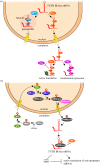Short interspersed nuclear element (SINE)-mediated post-transcriptional effects on human and mouse gene expression: SINE-UP for active duty
- PMID: 32075563
- PMCID: PMC7061979
- DOI: 10.1098/rstb.2019.0344
Short interspersed nuclear element (SINE)-mediated post-transcriptional effects on human and mouse gene expression: SINE-UP for active duty
Abstract
Primate-specific Alu short interspersed nuclear elements (SINEs) and rodent-specific B and ID (B/ID) SINEs are non-autonomous and generally non-coding retrotransposons that have been copied and pasted into the respective genomes so as to constitute what is estimated to be a remarkable 13% and 8% of those genomes. In the context of messenger RNAs (mRNAs), those residing within 3'-untranslated regions (3'UTRs) can influence mRNA export from the nucleus to the cytoplasm, mRNA translation and/or mRNA decay via proteins with which they associate either individually or base-paired in cis or in trans with a partially complementary SINE. Each of these influences impinges on the primary function of mRNA, which is to serve as a template for protein synthesis. This review describes how human cells have used 3'UTR Alu elements to mediate post-transcriptional gene regulation and also describes examples of convergent evolution between human and mouse 3'UTR SINEs. This article is part of a discussion meeting issue 'Crossroads between transposons and gene regulation'.
Keywords: 3′-untranslated regions; double-stranded RNA-binding proteins; mRNA export; mRNA translation, mRNA decay; short interspersed elements.
Conflict of interest statement
I declare I have no competing interests.
Figures


Similar articles
-
Evidence for convergent evolution of SINE-directed Staufen-mediated mRNA decay.Proc Natl Acad Sci U S A. 2018 Jan 30;115(5):968-973. doi: 10.1073/pnas.1715531115. Epub 2018 Jan 16. Proc Natl Acad Sci U S A. 2018. PMID: 29339519 Free PMC article.
-
Control of myogenesis by rodent SINE-containing lncRNAs.Genes Dev. 2013 Apr 1;27(7):793-804. doi: 10.1101/gad.212639.112. Epub 2013 Apr 4. Genes Dev. 2013. PMID: 23558772 Free PMC article.
-
Novel Role of 3'UTR-Embedded Alu Elements as Facilitators of Processed Pseudogene Genesis and Host Gene Capture by Viral Genomes.PLoS One. 2016 Dec 29;11(12):e0169196. doi: 10.1371/journal.pone.0169196. eCollection 2016. PLoS One. 2016. PMID: 28033411 Free PMC article.
-
Genomic gems: SINE RNAs regulate mRNA production.Curr Opin Genet Dev. 2010 Apr;20(2):149-55. doi: 10.1016/j.gde.2010.01.004. Epub 2010 Feb 20. Curr Opin Genet Dev. 2010. PMID: 20176473 Free PMC article. Review.
-
Does SINE evolution preclude Alu function?Nucleic Acids Res. 1998 Oct 15;26(20):4541-50. doi: 10.1093/nar/26.20.4541. Nucleic Acids Res. 1998. PMID: 9753719 Free PMC article. Review.
Cited by
-
The Dynamic Landscape of 3'-UTR Alternative Polyadenylation Across Mouse Fetal Development and Anatomy.Adv Sci (Weinh). 2025 May;12(19):e2502443. doi: 10.1002/advs.202502443. Epub 2025 Mar 24. Adv Sci (Weinh). 2025. PMID: 40126195 Free PMC article.
-
To "Z" or not to "Z": Z-RNA, self-recognition, and the MDA5 helicase.PLoS Genet. 2021 May 13;17(5):e1009513. doi: 10.1371/journal.pgen.1009513. eCollection 2021 May. PLoS Genet. 2021. PMID: 33983939 Free PMC article. Review.
-
Dynamic Variations of 3'UTR Length Reprogram the mRNA Regulatory Landscape.Biomedicines. 2021 Oct 28;9(11):1560. doi: 10.3390/biomedicines9111560. Biomedicines. 2021. PMID: 34829789 Free PMC article. Review.
-
Molecular mechanisms of adaptive evolution in wild animals and plants.Sci China Life Sci. 2023 Mar;66(3):453-495. doi: 10.1007/s11427-022-2233-x. Epub 2023 Jan 13. Sci China Life Sci. 2023. PMID: 36648611 Free PMC article. Review.
-
Crossroads between transposons and gene regulation.Philos Trans R Soc Lond B Biol Sci. 2020 Mar 30;375(1795):20190330. doi: 10.1098/rstb.2019.0330. Epub 2020 Feb 10. Philos Trans R Soc Lond B Biol Sci. 2020. PMID: 32075561 Free PMC article.
References
Publication types
MeSH terms
Substances
Grants and funding
LinkOut - more resources
Full Text Sources

